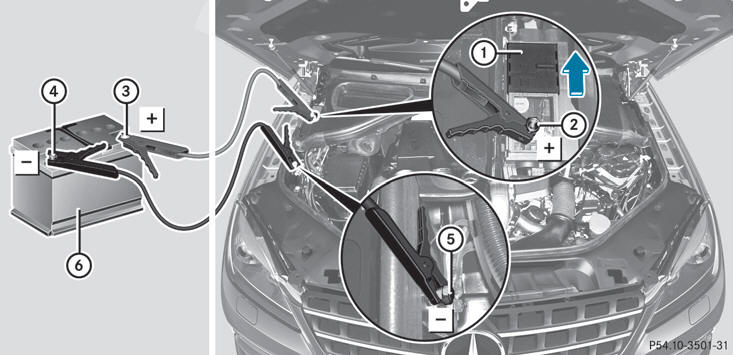Jump-starting
 WARNING
WARNING
Failure to follow these directions will cause damage to the electronic
components, and can lead
to a battery explosion and severe injury or death.
Never lean over batteries while connecting or jump starting. You might get
injured.
Battery fluid contains sulfuric acid. Do not allow this fluid to come in contact
with eyes, skin or
clothing. In case it does, immediately flush affected area with water, and seek
medical help if
necessary.
A battery will also produce hydrogen gas, which is flammable and explosive. Keep
flames or
sparks away from battery, avoid improper connection of jumper cables, smoking,
etc.
Attempting to jump start a frozen battery can result in it exploding, causing
personal injury.
Read all instructions before proceeding.
 Avoid repeated and lengthy starting attempts. Otherwise, non-combusted fuel may
damage the catalytic converter and create a risk of fire.
Avoid repeated and lengthy starting attempts. Otherwise, non-combusted fuel may
damage the catalytic converter and create a risk of fire.
Do not use a rapid-charging device to start the engine.
Make sure the jumper cables are not damaged.
Make sure the jumper cables are not touching any other metal objects when they
are
connected to the battery.
If your vehicle's battery is discharged, the engine can be jump-started from another vehicle or from a second battery using jumper cables.
Observe the following points:
Ц The battery is not accessible in all vehicles. If the other vehicle's battery
is not accessible,
jump-start the vehicle using a second battery or a jump-starting device.
Ц Only jump-start the vehicle when the engine is cold and the catalytic
converter system has
cooled down.
Ц Do not start the engine if the battery is frozen. Let the battery thaw
first.
Ц Jump-starting may only be performed from batteries with a nominal voltage of
12 V.
Ц Only use jumper cables which have a sufficient cross-section and insulated
terminal clamps.
Ц Make sure that the jumper cables cannot come into contact with parts, such as
the pulley
or the fan. These parts move when the engine is started and while it is
running.
Ц If the battery is fully discharged, leave the battery that is being used to
jump-start connected
for a few minutes before attempting to start. This charges the empty battery a
little.
 Jumper cables and further information about jump-starting can be obtained from
any
authorized Mercedes-Benz Center, for example.
Jumper cables and further information about jump-starting can be obtained from
any
authorized Mercedes-Benz Center, for example.
Ц Make sure that the two vehicles do not touch.
Ц Secure the vehicle by applying the electric parking brake.
Ц Shift the transmission to position P.
Ц Turn the SmartKey to position 0 in the ignition lock and remove it. On
vehicles
with KEYLESS-GO, make sure the ignition is switched off. All indicator lamps
in the instrument cluster must be off.
Ц Switch off all electrical consumers (e.g. radio, blower, etc.).
Ц Open the hood

Position number 6 identifies the charged battery of the other vehicle or an
equivalent jumpstarting
device.
Ц Slide cover 1 of positive terminal 2 in the direction of the arrow.
Ц Connect positive terminal 2 on your vehicle to positive terminal 3 of donor
battery 6
using the jumper cable, beginning with your own battery.
Ц Start the engine of the donor vehicle and run it at idling speed.
Ц Connect negative terminal 4 of donor battery 6 to earth point 5 of your
vehicle using
the jumper cable, connecting the jumper cable to donor battery 6 first.
Ц Start the engine.
Ц Allow the engine to run for a few minutes before disconnecting the jumper
cable.
Ц First, remove the jumper cable from earth point 5 and negative terminal 4,
then from
positive terminal 2 and positive terminal 3, each time disconnecting from the
contacts
on your own vehicle first.
Ц After removing the jumper cable, close cover 1 on positive terminal 2.
Ц Have the battery checked at a qualified specialist workshop, e.g. an
authorized Mercedes-
Benz Center. The jump-starting procedure is not a standard operating state;
therefore, have
the battery checked.
See also:
Engine
Problem
Possible causes/consequences and
Solutions
The
yellow Check
Engine warning lamp
lights up while the
engine is running.
There may be a malfunction, fo ...
Approach/departure angle
1 Approach/departure angle, front
2 Approach/departure angle, rear
Х Comply with the rules for off-road
driving.
Х Do not drive at an angle on slopes,
inclines or gradients, but instead fol ...
Conditions for activation
RACE START can be activated when:
- the doors are closed.
- the engine is running and it has reached an
operating temperature of approximately
176 ∞F (80
∞C). This is the case ...
